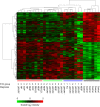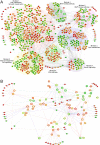Systems biology of interstitial lung diseases: integration of mRNA and microRNA expression changes
- PMID: 21241464
- PMCID: PMC3035594
- DOI: 10.1186/1755-8794-4-8
Systems biology of interstitial lung diseases: integration of mRNA and microRNA expression changes
Abstract
Background: The molecular pathways involved in the interstitial lung diseases (ILDs) are poorly understood. Systems biology approaches, with global expression data sets, were used to identify perturbed gene networks, to gain some understanding of the underlying mechanisms, and to develop specific hypotheses relevant to these chronic lung diseases.
Methods: Lung tissue samples from patients with different types of ILD were obtained from the Lung Tissue Research Consortium and total cell RNA was isolated. Global mRNA and microRNA were profiled by hybridization and amplification-based methods. Differentially expressed genes were compiled and used to identify critical signaling pathways and potential biomarkers. Modules of genes were identified that formed a regulatory network, and studies were performed on cultured cells in vitro for comparison with the in vivo results.
Results: By profiling mRNA and microRNA (miRNA) expression levels, we found subsets of differentially expressed genes that distinguished patients with ILDs from controls and that correlated with different disease stages and subtypes of ILDs. Network analysis, based on pathway databases, revealed several disease-associated gene modules, involving genes from the TGF-β, Wnt, focal adhesion, and smooth muscle actin pathways that are implicated in advancing fibrosis, a critical pathological process in ILDs. A more comprehensive approach was also adapted to construct a putative global gene regulatory network based on the perturbation of key regulatory elements, transcription factors and microRNAs. Our data underscores the importance of TGF-β signaling and the persistence of smooth muscle actin-containing fibroblasts in these diseases. We present evidence that, downstream of TGF-β signaling, microRNAs of the miR-23a cluster and the transcription factor Zeb1 could have roles in mediating an epithelial to mesenchymal transition (EMT) and the resultant persistence of mesenchymal cells in these diseases.
Conclusions: We present a comprehensive overview of the molecular networks perturbed in ILDs, discuss several potential key molecular regulatory circuits, and identify microRNA species that may play central roles in facilitating the progression of ILDs. These findings advance our understanding of these diseases at the molecular level, provide new molecular signatures in defining the specific characteristics of the diseases, suggest new hypotheses, and reveal new potential targets for therapeutic intervention.
Figures







Comment in
-
Findings of Research Misconduct.Fed Regist. 2013 Aug 6;78(151):47699. Fed Regist. 2013. PMID: 27737229 Free PMC article. No abstract available.
References
-
- Ellis R. Interstitial lung diseases: clinical features and management. Nurs Times. 2005;101:58–61. - PubMed
-
- Crystal RG, Bitterman PB, Mossman B, Schwarz MI, Sheppard D, Almasy L, Chapman HA, Friedman SL, King TE Jr, Leinwand LA. et al.Future research directions in idiopathic pulmonary fibrosis: summary of a National Heart, Lung, and Blood Institute working group. Am J Respir Crit Care Med. 2002;166:236–246. doi: 10.1164/rccm.2201069. - DOI - PubMed
Publication types
MeSH terms
Substances
Grants and funding
LinkOut - more resources
Full Text Sources
Other Literature Sources
Medical
Molecular Biology Databases

